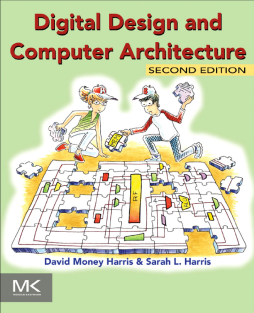
Additional Information
Book Details
Abstract
Digital Design and Computer Architecture, Second Edition, takes a unique and modern approach to digital design, introducing the reader to the fundamentals of digital logic and then showing step by step how to build a MIPS microprocessor in both Verilog and VHDL. This new edition combines an engaging and humorous writing style with an updated and hands-on approach to digital design. It presents new content on I/O systems in the context of general purpose processors found in a PC as well as microcontrollers found almost everywhere.
Beginning with digital logic gates and progressing to the design of combinational and sequential circuits, the book uses these fundamental building blocks as the basis for the design of an actual MIPS processor. It provides practical examples of how to interface with peripherals using RS232, SPI, motor control, interrupts, wireless, and analog-to-digital conversion. SystemVerilog and VHDL are integrated throughout the text in examples illustrating the methods and techniques for CAD-based circuit design. There are also additional exercises and new examples of parallel and advanced architectures, practical I/O applications, embedded systems, and heterogeneous computing, plus a new appendix on C programming to strengthen the connection between programming and processor architecture.
This new edition will appeal to professional computer engineers and to students taking a course that combines digital logic and computer architecture.
- Updated based on instructor feedback with more exercises and new examples of parallel and advanced architectures, practical I/O applications, embedded systems, and heterogeneous computing
- Presents digital system design examples in both VHDL and SystemVerilog (updated for the second edition from Verilog), shown side-by-side to compare and contrast their strengths
- Includes a new chapter on C programming to provide necessary prerequisites and strengthen the connection between programming and processor architecture
- Companion Web site includes links to Xilinx CAD tools for FPGA design, lecture slides, laboratory projects, and solutions to exercises
- Instructors can also register at textbooks.elsevier.com for access to: Solutions to all exercises (PDF), Lab materials with solutions, HDL for textbook examples and exercise solutions, Lecture slides (PPT), Sample exams, Sample course syllabus, Figures from the text (JPG, PPT)
"…intended as a course text for college or university level students, this book would serve just as well for anyone who just wants to learn about computer architecture or design… it stands as one of the best introductions to the subject and seems ideal for anyone wanting to learn digital design with no prior knowledge. The time investment would be handsomely rewarded and the range of topics covered, as well as the clear explanation of trickier issues, is extremely impressive." --BCS.org, April 2013
"Harris and Harris have taken the popular pedagogy from Computer Organization and Design down to the next level of refinement, showing in detail how to build a MIPS microprocessor in both Verilog and VHDL. Given the exciting opportunity that students have to run large digital designs on modern FGPAs, the approach the authors take in this book is both informative and enlightening." --David A. Patterson, University of California at Berkeley, Co-author of Computer Organization and Design
"Developed at Harvey Mudd College, this undergraduate textbook introduces combinatorial logic and sequential logic circuit design, describes the computer's microarchitecture that connects hardware with software, and explains how to build a MIPS microprocessor." --Reference and Research Book News, February 2013
